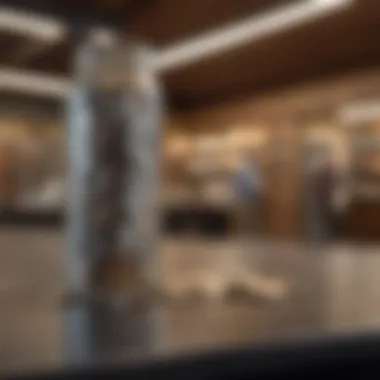The Economic Impact of the 1400 Stimulus Check


Intro
The introduction of the 1400 stimulus check in the wake of a global pandemic raised numerous questions about its effectiveness and long-term implications. While designed as an immediate relief measure, the potential consequences extended far beyond simply putting money in people's pockets. Understanding how this financial aid influenced personal finances and contributed to broader economic patterns can offer invaluable insights.
In today's economic landscape, the 1400 check serves as a crucial case study in fiscal policy and its repercussions. Did it truly help those in dire need, or did it create new challenges? Also, what role did this payment play in shaping recipients' financial habits and decision-making processes? These inquiries beckon a closer examination of personal finance management, investment strategies, retirement planning, and other financial products.
Prolusion to the Stimulus Check
The 1400 stimulus check is a significant aspect of the financial landscape that emerged during an unprecedented time in modern history. As society grappled with the repercussions of the Covid-19 pandemic, this direct financial assistance aimed to provide relief and spark some economic revival. Understanding the implications of such a measure involves delving into its background and objectives, as well as the effects on both individual recipients and the economy as a whole.
The importance of this topic lies not only in the immediate benefits that the stimulus check provided but also in its broader significance for fiscal policy and its influence on spending habits. Many individuals found themselves navigating financial uncertainties, and this aid injected a much-needed lifeline into households across the nation. While the check was seen as a temporary fix, it also revealed deeper insights into how societies manage economic stress.
Background of the Stimulus Checks
The concept of stimulus checks is not entirely new. Various forms of direct payments have been issued throughout history to combat economic downturns. The latest installment, however, came with unique complications due to the pandemic's widespread impact.
Initially, the financial assistance started in 2020 with the CARES Act, which laid the groundwork for future checks. The idea was straightforward: put money directly in the hands of consumers so that they could continue to spend and support local businesses, thus propelling the economy. The 1400-dollar check followed, targeting those who may not have seen sufficient aid previously. This approach illustrated a shift toward more immediate support mechanisms, contrasting with traditional methods that longer rely on tax credits or indirect benefits.
Purpose and Objectives
The primary objective of the 1400 stimulus check was to alleviate financial burdens faced by countless Americans. It aimed to achieve several key goals:
- Provide Immediate Relief: For many, these funds covered essential expenses - groceries, rent, and utility bills. In uncertain times, these necessities often felt overwhelming; the stimulus aimed to reduce that burden.
- Stimulate Economic Activity: By giving money directly to consumers, the hope was that they would spend and help jumpstart economic growth. With stores closed and services restricted, encouraging consumer spending became vital.
- Support Vulnerable Populations: The check particularly focused on individuals and families who had been adversely affected by job losses or reduced income options.
The complexities of each of these objectives unveiled a more intricate narrative of economic recovery that extended well beyond the act of handing out cash. Individuals faced pressures not just to survive but to plan for an uncertain future, thereby making the implications of the 1400 stimulus check a rich subject worthy of thorough analysis.
Understanding the dynamics at play with the stimulus checks is pivotal for grasping their effects on personal finance and the broader economy. It invites us to consider future policies that may take a similar approach.
Understanding Eligibility Criteria
Understanding the eligibility criteria for the 1400 stimulus check is pivotal, as it defines who benefited from this financial aid and reflects governmental aims to alleviate economic hardship. These criteria not only ensure that aid reaches its intended recipients but also spark discussions around fairness and need in a recovering economy.
Income Thresholds
The income thresholds are the primary factor determining who qualifies for the 1400 stimulus check. Congress set these limits to target aid effectively. For most individuals, the taxable income should not exceed $75,000 to qualify for the full amount. Married couples filing jointly face a threshold of $150,000. As for those above these figures, the check gradually diminishes; for every $100 over the limit, the amount is reduced by $5. This means that someone earning $80,000 might still receive a partial check, while individuals at $99,000 will receive none.
Few might argue the merits of such thresholds. By concentrating aid on lower-income Americans, policymakers aim to bolster spending in areas most affected by the pandemic. This approach reflects a philosophy of support grounded in immediate need rather than universal distribution. However, controversy lingers, as many have pointed out that certain essential workers still find themselves edged out, despite their income being near the threshold, given their crucial roles during the emergency.
The income threshold system thus illustrates a delicate balancing act between equity and simplicity.
Dependent Considerations
Dependent considerations add layers to the eligibility puzzle, especially for families seeking assistance. Eligible recipients who have dependents can receive an additional payment of $1,400 per qualifying dependent. This provision not only acknowledges the financial burdens of raising children but also expands the reach of the stimulus check to include those who often feel the squeeze of expenses, especially amid a crisis.
However, determining who qualifies as a dependent can provoke discussions and confusion. Generally, a dependent must meet specific criteria—being under 19 (or a full-time student under 24), living with the taxpayer for more than half the year, and relying on the taxpayer for care. With such stipulations, the eligibility can change considerably for families undergoing transitions, for example, divorce or shared custody arrangements.
Moreover, the aid's impact on diverse family structures showcases the varying needs across America's socioeconomic landscape. For many, the additional funds can help ease the burden of necessities. For others, it merely qualifies them for a lifeline that barely scratches the surface of their financial woes.
This complex interplay of income thresholds and dependent considerations drives home the variations in individuals' experiences with the stimulus check.
In the end, understanding these eligibility criteria offers insights into broader socio-economic discussions surrounding relief efforts. As we navigate these considerations, it becomes apparent that they are not just numbers on a paper; they reflect real lives and hardships, shaping how aid is perceived and utilized.
Mechanisms of Distribution
The mechanisms of distribution for the 1400 stimulus check significantly shaped both individual experiences and the broader economic landscape. Understanding how these checks were delivered is crucial for grasping their impact. The two primary methods—direct deposits and physical checks—affected how quickly funds reached recipients and how they were utilized. Each method has its distinct advantages and potential pitfalls that need careful consideration.
Direct Deposits
Direct deposits were the favored method for distributing the stimulus money, providing a swift and efficient channel for many recipients. By linking bank accounts directly with the distribution system, recipients typically received funds much faster than those waiting for physical checks. Usually, money arrived within days of the official announcement, minimizing anxiety for many households. Less risk of theft or loss further cemented direct deposits as a reliable choice.
Despite the convenience, there are challenges too. For example, not all individuals have bank accounts, which means some who needed financial aid the most could be left out. According to a report from the Federal Reserve, nearly a quarter of adults had no access to banking services or faced high fees that made it infeasible to maintain a checking account. This created a gap whereby a portion of the economically vulnerable population might not receive assistance in a timely manner.
Physical Checks
On the other hand, physical checks offered a tangible means of receiving funds. While these checks allowed those without bank accounts to participate, they also brought delays into the equation. Some households spent weeks waiting for their checks to arrive in the mail, which could lead to confusion and frustration. When checks were sent, the eligibility for receiving one often depended on past tax filings, which sometimes introduced further complications in delivery.


Moreover, there was a significant portion of the population that, while able to receive checks, faced hurdles like needing to cash them, which often included fees. Some banks, particularly community banks, were more accommodating regarding cashing checks, but overall, inconvenience loomed large for many.
Economic Impact on Speed of Distribution
The speed of distribution method resulted in different economic impacts within the community. Faster flows of money into the economy—such as via direct deposits—tended to boost local business spending, as recipients used the funds quicker to purchase essentials or pay debts. An analysis by the National Bureau of Economic Research reported that households with direct deposits showed a notable upsurge in expenditures shortly after the funds arrived, which, in turn, helped stabilize some small businesses during uncertain times.
Conversely, physical checks led to a more staggered economic response. Those waiting on checks typically delayed spending, impacting local businesses relying on consistent transactions. As businesses faced fluctuating foot traffic, the overall market risks and uncertainties increased. Changes in consumer behavior often translated to broader economic challenges regarding recovery.
"The method through which funds are distributed not only affects the recipients but also ripples out to influence economic performance on a larger scale."
Analyzing the Economic Impact
Examining the economic consequences of the $1400 stimulus check is vital for understanding how governmental interventions can alleviate financial hardships for individuals and broader society. This includes acknowledging how cash injections into the economy can stimulate spending, affecting sectors in various ways. Additionally, it prompts a discussion about potential long-term consequences that arise from such sudden fiscal measures. With these checks being a significant source of income for many, their effects ripple through both micro and macroeconomic landscapes.
Short-term Benefits
The immediate advantages of the stimulus checks did not take long to manifest. Many recipients saw this influx as a lifeline, especially in a time when job security hung by a thread. The short-term benefits can be categorized as follows:
- Increased Consumer Spending: A noticeable uptick in spending occurred almost as soon as checks were deposited. Households utilized the funds for necessities, ensuring that local businesses received a boost at a crucial time. The rush to purchase everything from groceries to household appliances showcased how stimulus funds can quickly circulate through local economies.
- Support for Debt Relief: For several, this windfall offered an opportunity to tackle outstanding debts. People used portions of their checks to chip away at credit card balances, reducing the financial burden that high-interest rates impose. Paying down debt not only benefits individual financial health but can enhance credit ratings, eventually allowing for better financial opportunities down the line.
- Enhanced Savings: Some individuals opted to save their checks rather than spend them immediately. Amidst uncertainty, bolstering emergency savings accounts became a prudent move for many families. This change in consumer behavior highlights a shift towards financial prudence, as statistics show an increase in bank deposits following the distribution of the checks.
As noted in various economic analyses, these short-term benefits are like pouring fuel on the fire of economic activity, helping pave the way for a slight recovery amidst challenging times.
"In the world of economics, a dollar saved can sometimes be more powerful than a dollar spent."
Long-term Economic Implications
While the short-term effects are measurable and often celebrated, the long-term implications carry nuances that demand attention. Evaluating these implications raises questions about sustainability and potential consequences for future fiscal policies. Key points include:
- Inflation Concerns: One of the noteworthy discussions around stimulus checks is the fear of inflation. Critics argue that injecting large sums of money into the economy without commensurate growth in goods and services could lead to rising prices. This concept challenges policymakers to balance the amount of liquidity in the economy with production capacities to avoid devaluing currency and eroding purchasing power.
- Behavioral Shifts in Consumer Patterns: Observations post-check distributions suggest changes in consumer behavior. Those who used their funds for leisure purchases or non-essential items may have relaxed their financial priorities. As buying habits evolve, businesses may need to pivot to accommodate these shifts, which could impact their long-term viability.
- Investment in Human Capital: On a positive note, some individuals chose to use their checks toward personal developments, such as education or skills training. Such investments can have profound long-term benefits by enhancing employability and contributing to a more skilled workforce, reflecting a holistic view of welfare that extends beyond immediate financial relief.
Personal Finance Strategies Following Receipt
When the 1400 stimulus check landed in the bank accounts of millions, it presented not just a windfall but a chance to reassess personal finances. Given the socio-economic turbulence facing many, the manner in which recipients managed these funds could lay groundwork for future financial security. Thus, discussing personal finance strategies after receipt of this check is paramount for anyone looking to make the most of their unexpected cash.
Savings and Emergency Funds
Setting aside a portion of the stimulus check for savings or an emergency fund can be a game changer. Life tosses curveballs – unexpected car repairs, medical expenses, or sudden job loss. Having a financial cushion can alleviate stress during these uncertain times. But how much should one save?
General wisdom points towards saving at least 20% of any windfall. For instance, someone receiving a $1400 check might set aside $280, instantly boosting their emergency fund.
- Benefits of Saving:
- Peace of mind
- Increased financial flexibility
- Ability to withstand sudden expenses
Certainly, it often feels better to splurge, but packing money away could lead to more substantial financial health.
Debt Management Considerations
Addressing outstanding debt is another crucial use of the stimulus check. The nature of debt varies widely—credit cards, student loans, and personal loans each come with its own implications. Prioritizing high-interest debt often makes the most sense; even a small payment can lead to significant savings over time.
Suppose someone has $1000 in credit card debt with an interest rate of 20%. Paying off that debt with part of the stimulus check can save hundreds in interest over the year.
- Strategies to consider:
- Snowball Method: Pay off smaller debts first for motivation.
- Avalanche Method: Focus on high-interest debts first to save on overall interest.
This not only reduces stress but sets the stage for healthier financial habits moving forward.
Investment Opportunities
Investing can feel daunting, especially if one isn't familiar with the landscape. However, the stimulus check can serve as an excellent stepping stone to entering the investment world. Instead of letting cash sit idle, one can engage in opportunities that could yield growth.
- Options to explore:
- Stock Market: Investing in a diversified portfolio can be a robust option, with platforms like Robinhood or E*TRADE accessible for beginners.
- Retirement Accounts: Contributing to a Roth IRA might be wise, especially if you’re eyeing long-term growth.


Each investment avenue comes with its own risks, but educating oneself and starting small can lead to substantial benefits.
Variations in Recipients' Experiences
The 1400 stimulus check has been a lifeline for many, yet its impact varies significantly among different recipients. Understanding these variations is crucial to grasping the overall effects of the program. From low-income households struggling to make ends meet to wealthier individuals who may see the check as an unexpected bonus, the experiences paint a varied picture of financial relief. This section looks at how demographic and economic factors shape distinct experiences, highlighting the need for nuanced approaches to fiscal support measures.
Low-Income Households
For many low-income households, the 1400 stimulus check represented much-needed relief in a time of crisis. Families in this position often faced overwhelming financial burdens, such as rent, utilities, and grocery bills. With many businesses shuttered during the pandemic, jobs were either lost or significantly reduced. The infusion of cash from the check helped ease these stresses, allowing for essential expenses to be paid. Survey data suggest that a large portion of this demographic used the funds for health care, food, and housing needs.
Additionally, the check allowed some households to start small budgeting efforts that they hadn't managed before. Here are some points to consider:
- Immediate Relief: The funds helped cover basic needs, critical during high unemployment rates.
- Long-term Resilience: Some families began establishing emergency funds, marking a shift in financial behavior.
- Community Impact: Local businesses saw a slight uptick in spending, helping stimulate their recovery efforts.
In essence, for low-income recipients, the 1400 stimulus check was not just money; it was a chance to regain some stability in turbulent times.
Middle-Income Families
Middle-income families found themselves in a different position regarding the stimulus check. Many faced challenges due to rising costs of living, and while the check served as additional support, its impact was sometimes overshadowed by existing financial obligations. Families in this bracket often had more flexibility than their lower-income counterparts but still had significant bills.
The 1400 stimulus check was frequently utilized in various ways:
- Debt Reduction: Several families opted to pay off credit card balances, thus avoiding high-interest costs.
- Education Expenses: Some used the funds to cover tuition fees or educational materials for children.
- Home Improvement Projects: With more time spent at home, some families invested in renovations or repairs.
A notable observation is that while most middle-income families benefited, their approach often involved strategic spending rather than urgent necessity. The check might have boosted their quality of life, but it didn’t necessarily alter their financial trajectory dramatically.
Wealthier Individuals
For wealthier individuals, the 1400 stimulus check was often perceived differently. Many already possessed sufficient resources to weather the economic challenges posed by the pandemic, leaving them in a unique situation. The check, viewed as somewhat of a windfall, likely found its way into savings accounts or investment portfolios.
Characteristics of how wealthier individuals approached the stimulus check include:
- Investment Opportunities: Some saw the funds as a chance to further invest in stocks or real estate, capitalizing on fluctuating market conditions.
- Charitable Contributions: A number of wealthier recipients chose to donate their checks to various causes, emphasizing support for communities hit hardest by the pandemic.
- Luxury Spending: For a small segment, there was a tendency to indulge in non-essentials, like luxury goods or experiences that were previously restricted.
In summary, while wealthier individuals did benefit from the stimulus check, the emphasis was more on strategic management of finances and potential philanthropic pursuits than on immediate survival.
The diverse experiences of different income groups illustrate the multi-layered impacts of fiscal measures like the 1400 stimulus check, showing the need for tailored policies in future recovery efforts.
Impacts on Consumer Spending
The impact of the 1400 stimulus check on consumer spending cannot be overstated. This substancial financial aid has acted as a catalyst in various economic sectors, establishing spending patterns that may evolve into lasting trends. By injecting cash into the hands of consumers, the government aimed to reinvigorate an economy suffering under the pressures of a pandemic. Understanding how this financial support has shaped spending behaviors illuminates not only immediate reactions but also potential longer-term shifts.
Sector Analysis
Consumer spending was noticeably insulated post-stimulus, with certain sectors experiencing an explosive growth that was strikingly disproportionate. For example, retailers and e-commerce platforms witnessed boons as individuals opted to splurge after periods of frugality.
- Retail and E-commerce:
- Travel and Hospitality:
- Entertainment and Dining:
- Overall spending in retail rose as people decided to indulge in shopping.
- Major platforms such as Amazon and Walmart saw not only a spike in transaction volume but also an elevation in average spending per customer.
- As vaccines rolled out, there was a notable uptick in bookings for travel, indicating a pent-up desire to explore after months of confinement.
- Many sectors within this domain struggled to keep up with demand, leading to a surge in prices amid limited supply.
- Restaurants and streaming services alike were bustling; individuals sought experiences and escapism, having missed out on social interactions.
- Substantial spending was noted in both the dining sector and in purchasing streaming subscriptions.
These shifts provide valuable insights. Consumers reacted swiftly to the stimulus, diverting their newfound cash mainly into sectors they had previously curtailed spending on. As a result, businesses adapted quickly, increasing inventory and enhancing services to capitalize on this unexpected windfall.
Behavioral Economics Perspectives
From the viewpoint of behavioral economics, the stimulus checks nudged individuals into a state of increased spending. The concept of mental accounting illustrates how people compartmentalize funds; many who received the check may have earmarked it for enjoyment rather than necessity.
- Loss Aversion:
- Instant Gratification:
- Social Influences:
- Some consumers inherently shy away from the fear of missing out on experiences, prompting them to utilize the check for immediate enjoyment rather than saving it.
- This behavior correlates directly with the emotional responses associated with financial windfalls.
- Immediate positive reinforcement often trumps long-term financial strategizing, especially in extraordinary times. People seem to prefer the joy of spending now rather than waiting for future benefits, leading to a portion of the stimulus being spent on non-essential items.


- Peer behaviors can significantly affect spending habits; if friends and family are spending their checks, there's a tendency for others in their circle to indulge similarly.
- The resulting social pressure may create a spending culture that is hard to shake off, even after the stimulus effects wane.
These economic layers weave a complex tapestry through which personal finances and societal values interplay. The 1400 stimulus check acted as a temporary lift, but a deeper understanding of spending behaviors may be necessary to recognize how such measures influence the economy beyond their immediate effects.
Understanding consumer spending patterns post-stimulus can guide future fiscal policies and personal finance strategies for individuals.
Fiscal Policy Insights
Understanding the implications of the 1400 stimulus check involves diving deep into fiscal policy insights. This matters because fiscal policies are essentially a government's way of managing its spending and taxation to influence the economy. The stimulus checks are a form of direct government intervention aimed at cushioning economic blows, promoting consumer spending, and stabilizing the economy during tough times.
Significance of Fiscal Policy
Fiscal policies are not just about numbers in a ledger; they're about people, lives, and livelihoods. When a government decides to cut taxes or increase spending, it directly impacts families, businesses, and entire communities. Here’s why the 1400 stimulus check fits into this broader context:
- Immediate Relief: The checks provided necessary relief to millions, aiming to offer a lifeline amidst uncertainty.
- Consumption Boost: By injecting money into consumers' pockets, the government hoped to boost spending, which, in turn, fuels economic recovery.
- Debt Accumulation Considerations: While stimulus checks have their benefits, they also raise concerns about national debt and future tax increases necessary to balance budgets.
"The 1400 stimulus check stands as a testament to the intricate dance between government intervention and market dynamics."
Understanding these factors helps paint a clearer picture of how such economic measures can ripple through the fiscal landscape.
Government Responses to Economic Crisis
Governments often find themselves in a tight spot during an economic crisis. The pandemic created an unprecedented scenario that required swift actions. The stimulus checks were part of a larger strategy to keep the economy afloat.
Here’s how the government responded, and what factors influenced those choices:
- Quick Rollout of Funds: The U.S. government prioritized speed in distributing the funds to those most in need. Waiting could mean more than just economic damage; it could mean the loss of homes or businesses.
- Broad Eligibility: Unlike previous checks that targeted specific demographics, the 1400 stimulus check aimed to include a wider range of citizens, instilling a broad sense of support.
- Layers of Support: The check was a mere piece of a larger puzzle, which included extended unemployment benefits, eviction moratoriums, and small business loans. This multifaceted response aimed to address various economic woes from multiple angles.
Lessons for Future Stimulus Measures
As we look ahead, examining the 1400 stimulus check also entails understanding what worked and what didn’t. Drawing lessons from this experience can help shape future fiscal policies effectively. Some key takeaways include:
- Direct Cash Transfers Work: Evidence suggests that providing immediate cash relief can prevent deeper recessions and spur quicker recoveries.
- Focus on Inclusivity: Future measures should ensure that the most vulnerable populations are adequately supported, given that the pandemic has highlighted long-standing inequalities.
- Communication is Key: Clear messaging about the purpose and process of such measures can alleviate confusion and ensure more people take advantage of available support.
Public Sentiment and Reactions
The emotions and thoughts surrounding the 1400 stimulus check are significant in understanding its overall impact. Public sentiment not only reflects individual experiences but also shapes broader economic trends. It becomes essential to examine how different demographics perceived and reacted to this financial aid. By diving into varied perspectives, one can better appreciate how the stimulus check influenced the collective mood of the economy, which in turn affects spending habits and future policy decisions.
Diverse Perspectives
When discussing the diverse reactions to the stimulus check, it’s vital to consider the wide range of experiences. For many, the arrival of the $1400 check was a lifeline, symbolizing a hope for recovery amidst uncertainty. Positive sentiments were especially noticeable among low-income households who faced the brunt of economic hardships. Many of these individuals mentioned how the check allowed them to cover basic expenses like rent and groceries, easing their financial burden.
Others, especially within middle-income families, showed a mix of optimism and skepticism. While the windfall was a welcome relief, there was lingering apprehension about job stability and rising living costs. A common sentiment among them was the notion, "This is great for now, but what’s next?". The feeling that the check was a temporary bandage on a larger wound was prevalent, feeding into a broader conversation about the sustainability of such aid in the futur.
On the other end of the spectrum, wealthier individuals reacted differently. Many viewed the stimulus check as unnecessary, often expressing concerns about government spending and potential tax repercussions. They echoed a sentiment of wonder about how such financial aid might affect inflation, hinting at a philosophy that questioned the efficacy of wealth redistribution through checks.
Concerns About Inflation
The specter of inflation loomed large over public discussions regarding the stimulus checks. As recipients celebrated the immediate financial relief, many economists and individuals alike raised flags about the future implications of injecting such a large sum of money into the economy. Concerns centered around the fear of increased prices for everyday goods, which could negate the financial benefits provided by the stimulus.
"It feels good to have some extra cash now, but will I later be paying more for bread and milk?"
This question resonates with a lot of people, revealing widespread anxiety. Particularly among middle-income households, there was a fear that their purchasing power might diminish as prices start to rise. Here are some points to consider:
- Historical Context: Previous large-scale fiscal interventions have sometimes led to spikes in inflation. Many were quick to reference the economic aftermath of the 2008 financial crisis.
- Market Reactions: Observing the stock market's response, there were noticeable fluctuations that raised flags about future economic stability. Many investors were wary, causing increased volatility.
- Consumer Behavior: Fear of inflation can alter spending habits. People might start saving more instead of spending, which could then slow down the very economic recovery that the stimulus check was meant to foster.
The nuanced reactions to the 1400 stimulus check illustrate an important truth: financial aid is rarely viewed solely through the lens of immediate relief. Instead, it sparks various discussions about future implications, showing how interconnected public sentiment is with economic trends and policies. Understanding these varied perspectives is crucial for grasping the complete picture of the stimulus check's impact.
Finale
The significance of the conclusion in this article cannot be understated. It serves as a critical reflection on the various dimensions explored regarding the 1400 stimulus check's consequences on both individual finances and the broader economic landscape. By summarizing the key findings, the conclusion reaffirms the article's core insights and provides clarity on how the stimulus check, despite its limitations, played a substantial role in shaping financial behaviors and attitudes during a challenging economic period.
Summarizing Key Findings
One crucial takeaway from this inquiry is the diverse impact of the 1400 stimulus check across various demographics. It is evident that:
- Low-Income Households: Many individuals in this group allocated their funds primarily towards essential expenses such as food, housing, and healthcare. This shows a pressing need for immediate financial relief rather than long-term investment strategies.
- Middle-Income Families: For these recipients, the stimulus check acted as a buffer, allowing them to save more or make modest investments. The research indicates that their financial strategies often included enhancing emergency funds or paying down debts.
- Wealthier Individuals: Interestingly, those in higher income brackets had a contrasting reaction to the funds. With a lower relative need for immediate relief, many chose to invest their checks or save for the future, thus amplifying concerns about wealth inequality.
These categorizations reveal distinct behavioral patterns that underscore the varying priorities of recipients based on their economic standing. Accentuating the need for tailored fiscal responses highlights a gap in understanding how diverse economic situations create different financial needs.
Implications for Personal Finance
Considering the insights gained, there are several implications for personal finance practices:
- Emergency Savings Strategies: Low-income households illustrate the pressing necessity for robust emergency funds. Setting aside funds for unexpected expenses can significantly reduce financial stress during crises.
- Debt Management: The tendency of middle-income families to prioritize debt repayment signals the importance of sound financial health. Leveraging stimulus funds for debt reduction can foster more sustainable household finances.
- Investment Acumen: Wealthier individuals underscore the potential for using lump sums like the stimulus check for investments. Such actions stress the importance of financial literacy, highlighting the need to educate individuals on prudent investing options, from stocks to real estate.







